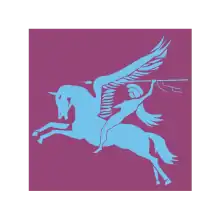| Special Air Service Troops | |
|---|---|
 As evidenced by period photographs, members of the brigade wore the Pegasus insignia of the British airborne forces. | |
| Active | 1944-1945 |
| Country | |
| Branch | |
| Type | Paratrooper, Special forces |
| Role | Airborne forces, Raiding, Reconnaissance |
| Size | Brigade |
| Motto(s) | Who Dares Wins |
| Insignia | |
| The insignia designed for the SAS in 1941 | .svg.png.webp) |
The Special Air Service Troops was a brigade sized formation of the Special Air Service, which was founded on 7 January 1944 in the United Kingdom during the Second World War. The formation was also known as the SAS Brigade. The brigade was a multi-national force of British, French, and Belgian units. On formation, the brigade commanded the 1st and 2nd Special Air Service regiments, the French 2nd and 3rd Parachute Battalions (also known as the 3rd and 4th SAS Regiments), and the Belgian Parachute Company. In March 1944, F Squadron, GHQ Liaison Regiment was added to the brigade. In 1945, the Belgian parachute company was redesignated as 5th Special Air Service. The French units were also redesignated as the 2nd Parachute Chasseur Regiment and the 3rd Parachute Chasseur Regiment (abbreviated as 2 RCP and 3 RCP).[1]
The brigade was initially commanded by Brigadier Roderick McLeod, until 14 March 1945 when Brigadier Mike Calvert took command. The brigade was stationed in the United Kingdom until May 1945, when the brigade headquarters moved to Norway. The brigade headquarters returned to the United Kingdom in June, and remained there for the duration of the war. Until April 1944, the brigade was assigned to Airborne Troops, before being placed under the command of the I Airborne Corps on 17 April. It remained under the command of the corps for the duration of the war.[1] The brigade's units, however, took part in various operations as part of the Northwest Europe Campaign of 1944–1945, which included operations such as Amherst, Bulbasket, Cooney, Dingson, Houndsworth, Lost, Loyton, Samwest, and Tombola.
Citations
- 1 2 Joslen 2003, p. 456.
References
- Joslen, H. F. (2003) [1960]. Orders of Battle: Second World War, 1939–1945. Uckfield, East Sussex: Naval and Military Press. ISBN 978-1-84342-474-1.